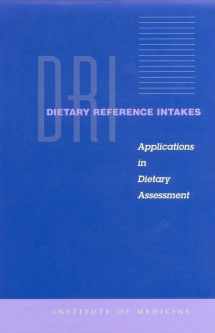
Dietary Reference Intakes: Applications in Dietary Assessment (Dietary Reference Intakes Series)
Book details
Summary
Description
Since 1994 the Institute of Medicine's Food and Nutrition Board has been involved in developing an expanded approach to developing dietary reference standards. This approach, the Dietary Reference Intakes (DRIs), provides a set of four nutrient-based reference values designed to replace the Recommended Dietary Allowances (RDAs) in the United States and the Recommended Nutrient Intakes (RNIs) in Canada. These reference values include Estimated Average Requirement (EAR), Recommended Dietary Allowance (RDA), Adequate Intake (AI), and Tolerable Upper Intake Level (UL). To date, several volumes in this series have been published.
This new book, Applications in Dietary Assessment, provides guidance to nutrition and health research professionals on the application of the new DRIs. It represents both a "how to" manual and a "why" manual. Specific examples of both appropriate and inappropriate uses of the DRIs in assessing nutrient adequacy of groups and of individuals are provided, along with detailed statistical approaches for the methods described. In addition, a clear distinction is made between assessing individuals and assessing groups as the approaches used are quite different. Applications in Dietary Assessment will be an essential companion to any-or all-of the DRI volumes.
- Front Matter
- Contents
- Summary
- I. Historical Perspective and Background
- 1 Introduction and Background
- 2 Current Uses of Dietary Reference Standards
- II. Application of DRIs for Individual Diet Assessment
- 3 Using Dietary Reference Intakes for Nutrient Assessment of Individuals
- III. Application of DRIs for Group Diet Assessment
- 4 Using the Estimated Average Requirement for Nutrient Assessment of Groups
- 5 Using the Adequate Intake for Nutrient Assessment of Groups
- 6 Using the Tolerable Upper Intake Level for Nutrient Assessment of Groups
- 7 Specific Applications: Assessing Nutrient Intakes of Groups Using the Dietary Reference Intakes
- IV. Fine-Tuning Dietary Assessment Using the DRIs
- 8 Minimizing Potential Errors in Assessing Group and Individual Intakes
- 9 Research Recommended to Improve the Uses of Dietary Reference Intakes
- 10 References
- Appendix A: Origin and Framework of the Development of Dietary Reference Intakes
- Appendix B: Nutrient Assessment of Individuals: Statistical Foundations
- Appendix C: Assessing Prevalence of Inadequate Intakes for Groups: Statistical Foundations
- Appendix D: Assessing the Performance of the EAR Cut-Point Method for Estimating Prevalence
- Appendix E: Units of Observation: Assessing Nutrient Adequacy Using Household and Population Data
- Appendix F: Rationale for Setting Adequate Intakes
- Appendix G: Glossary and Abbreviations
- Appendix H: Biographical Sketches of Subcommittee Members
- Index
- Summary Table: Estimated Average Requirements
- Summary Table: Tolerable Upper Intake Levels
- Summary Table: Recommended Intakes for Individuals


We would LOVE it if you could help us and other readers by reviewing the book
Book review



